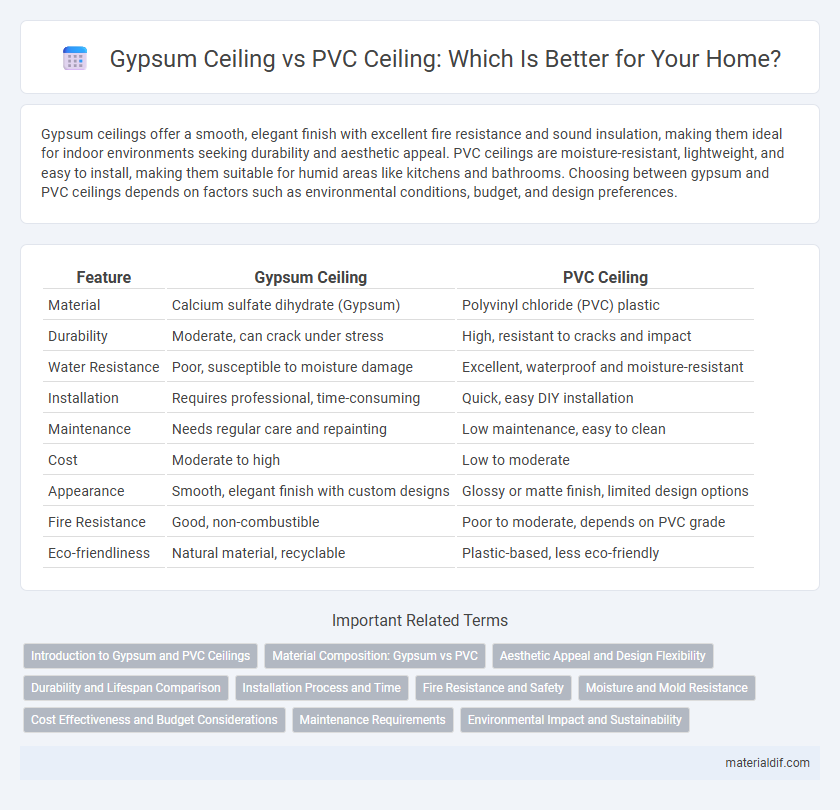Gypsum ceilings offer a smooth, elegant finish with excellent fire resistance and sound insulation, making them ideal for indoor environments seeking durability and aesthetic appeal. PVC ceilings are moisture-resistant, lightweight, and easy to install, making them suitable for humid areas like kitchens and bathrooms. Choosing between gypsum and PVC ceilings depends on factors such as environmental conditions, budget, and design preferences.
Table of Comparison
| Feature | Gypsum Ceiling | PVC Ceiling |
|---|---|---|
| Material | Calcium sulfate dihydrate (Gypsum) | Polyvinyl chloride (PVC) plastic |
| Durability | Moderate, can crack under stress | High, resistant to cracks and impact |
| Water Resistance | Poor, susceptible to moisture damage | Excellent, waterproof and moisture-resistant |
| Installation | Requires professional, time-consuming | Quick, easy DIY installation |
| Maintenance | Needs regular care and repainting | Low maintenance, easy to clean |
| Cost | Moderate to high | Low to moderate |
| Appearance | Smooth, elegant finish with custom designs | Glossy or matte finish, limited design options |
| Fire Resistance | Good, non-combustible | Poor to moderate, depends on PVC grade |
| Eco-friendliness | Natural material, recyclable | Plastic-based, less eco-friendly |
Introduction to Gypsum and PVC Ceilings
Gypsum ceilings, made from calcium sulfate dihydrate, offer excellent fire resistance, acoustic insulation, and a smooth, seamless finish ideal for modern interiors. PVC ceilings, constructed from polyvinyl chloride panels, provide moisture resistance, lightweight durability, and easy installation, making them suitable for humid environments. Both materials serve distinct purposes, with gypsum excelling in aesthetic and fire safety while PVC focuses on water resistance and maintenance simplicity.
Material Composition: Gypsum vs PVC
Gypsum ceilings are composed primarily of calcium sulfate dihydrate, a natural mineral known for its fire resistance and sound insulation properties, whereas PVC ceilings are made from polyvinyl chloride, a synthetic plastic polymer valued for its moisture resistance and lightweight nature. The inorganic nature of gypsum provides better breathability and helps regulate indoor humidity, contrasting with the non-breathable, water-resistant characteristics of PVC. These fundamental differences in material composition affect durability, installation, and environmental impact in interior ceiling applications.
Aesthetic Appeal and Design Flexibility
Gypsum ceilings offer a smooth, elegant finish with the ability to incorporate intricate designs and custom moldings, enhancing the overall aesthetic appeal of interior spaces. PVC ceilings provide vibrant color options and patterns that are resistant to moisture, making them suitable for contemporary designs in humid areas. The design flexibility of gypsum allows for seamless curves and detailed textures, whereas PVC ceilings excel in easy installation and maintenance with modular panel designs.
Durability and Lifespan Comparison
Gypsum ceilings offer superior fire resistance and can last up to 50 years with proper maintenance, making them a durable choice for indoor environments. PVC ceilings resist moisture, mold, and corrosion, providing longevity in humid conditions but typically have a lifespan of around 20-30 years. The choice between gypsum and PVC ceilings depends largely on environmental exposure and maintenance practices affecting their durability and overall lifespan.
Installation Process and Time
Gypsum ceilings require skilled labor for installation, involving the attachment of metal frames and precise fitting of plasterboards, typically taking 3 to 5 days for a standard room. PVC ceilings offer a quicker installation process, as lightweight panels are easily clipped or nailed onto existing frameworks, often completed within 1 to 2 days. The complexity and drying time of gypsum prolong its installation compared to the straightforward, moisture-resistant PVC ceiling panels.
Fire Resistance and Safety
Gypsum ceilings offer superior fire resistance due to their natural non-combustible properties and ability to withstand high temperatures, making them a safer choice for fire-prone areas. PVC ceilings, while lightweight and moisture-resistant, are combustible and can emit toxic fumes when exposed to fire, posing significant safety risks. Fire safety regulations often recommend gypsum ceilings for commercial and residential buildings to enhance overall fire protection.
Moisture and Mold Resistance
Gypsum ceilings are prone to moisture absorption and can develop mold in high-humidity environments, making them less suitable for damp areas. PVC ceilings offer superior moisture resistance due to their waterproof properties, preventing mold growth and maintaining durability in bathrooms and kitchens. Choosing PVC ceilings enhances indoor air quality by reducing mold-related health risks compared to traditional gypsum ceilings.
Cost Effectiveness and Budget Considerations
Gypsum ceilings offer a competitive advantage in cost effectiveness due to their affordability and ease of installation compared to PVC ceilings, which tend to have higher material costs. Gypsum provides better thermal insulation and durability, reducing long-term maintenance expenses and enhancing budget efficiency. PVC ceilings, while lightweight and moisture-resistant, often incur increased replacement costs, making gypsum a more budget-friendly option for extensive ceiling projects.
Maintenance Requirements
Gypsum ceilings require regular inspection for cracks and water damage, as they are sensitive to moisture and can deteriorate if not properly maintained. PVC ceilings offer low maintenance benefits, being waterproof and resistant to mold, stains, and warping. Choosing between gypsum and PVC ceilings depends on the desired balance between aesthetic appeal and ease of upkeep.
Environmental Impact and Sustainability
Gypsum ceilings are more environmentally sustainable due to their natural composition, recyclability, and ability to regulate indoor humidity, reducing energy consumption for climate control. PVC ceilings, derived from non-renewable petroleum, pose environmental risks through toxic emissions during production and disposal, and are less biodegradable. Choosing gypsum supports lower carbon footprints and healthier indoor air quality, aligning with green building standards.
Gypsum ceiling vs PVC ceiling Infographic

 materialdif.com
materialdif.com